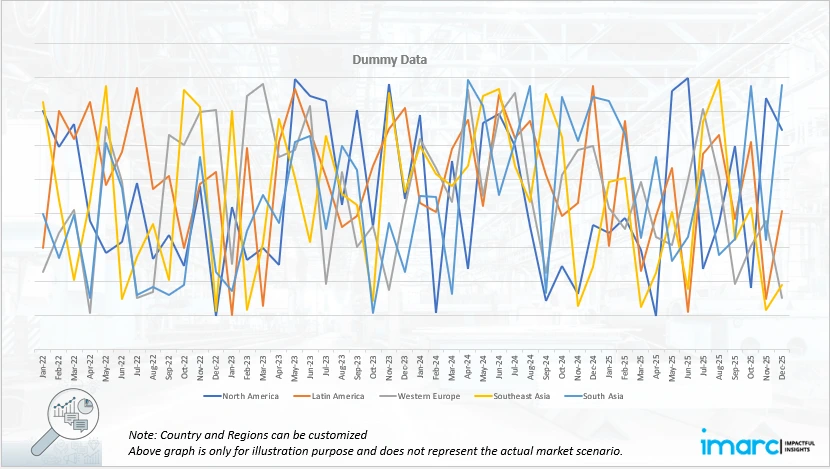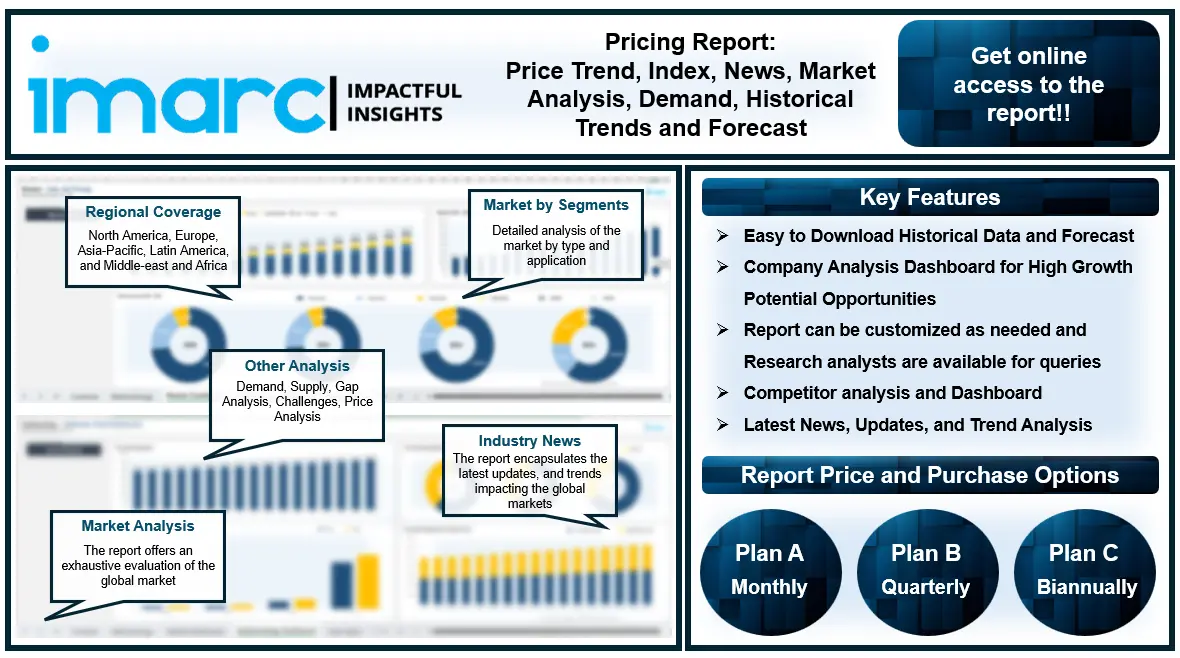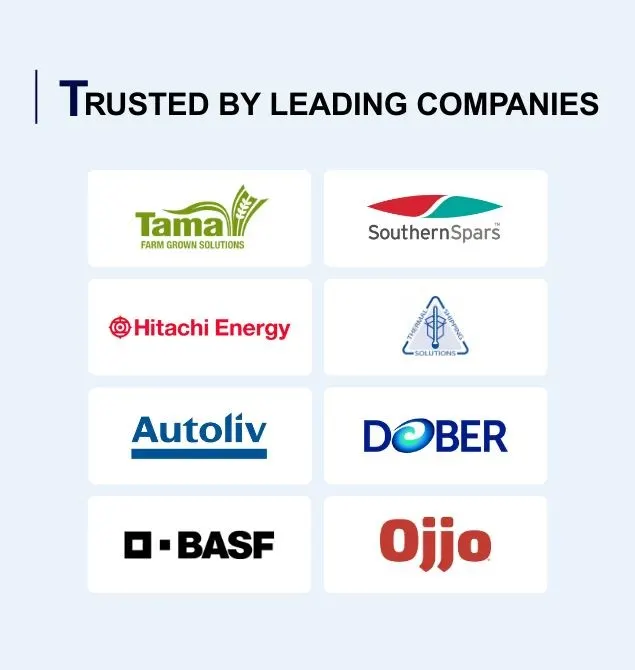
Polyhydroxyalkanoates (PHA) Prices, Trend, Chart, Demand, Market Analysis, News, Historical and Forecast Data Report 2025 Edition
Polyhydroxyalkanoates (PHA) Price Trend, Index and Forecast
Track the latest insights on polyhydroxyalkanoates (PHA) price trend and forecast with detailed analysis of regional fluctuations and market dynamics across North America, Latin America, Central Europe, Western Europe, Eastern Europe, Middle East, North Africa, West Africa, Central and Southern Africa, Central Asia, Southeast Asia, South Asia, East Asia, and Oceania.
Polyhydroxyalkanoates (PHA) Prices Outlook Q1 2025
- USA: US$ 3505/MT
- China: US$ 3373/MT
- France: US$ 2975/MT
- South Korea: US$ 2227/MT
- Brazil: US$ 2195/MT
Polyhydroxyalkanoates (PHA) Price Chart

Get real-time access to monthly/quaterly/yearly prices, Request Sample
During the first quarter of 2025, the polyhydroxyalkanoates (PHA) prices in the USA reached 3505 USD/MT in March. PHA production relies on carbon sources, like sugars or waste streams. Hence, as per the polyhydroxyalkanoates (PHA) price chart, fluctuations in the cost of these carbon sources directly affected PHA prices.
During the first quarter of 2025, polyhydroxyalkanoates (PHA) prices in China reached 3373 USD/MT in March. Advancements in biotechnology and microbial engineering increased the efficiency and cost-effectiveness of PHA production, leading to price reductions. Moreover, changes in supply chains and trade policies also affected PHA prices.
During the first quarter of 2025, the polyhydroxyalkanoates (PHA) prices in France reached 2975 USD/MT in March. Prices in France saw fluctuations due to a combination of factors, including advancements in biotechnology and fermentation processes, the rising cost of petroleum-based plastics, and research into reducing PHA production costs.
During the first quarter of 2025, the polyhydroxyalkanoates (PHA) prices in South Korea reached 2227 USD/MT in March. Changes in demand for PHAs, influenced by factors such as environmental regulations and consumer preferences, affected the prices.
During the first quarter of 2025, the polyhydroxyalkanoates (PHA) prices in Brazil reached 2195 USD/MT in March. Changes in demand for PHA from different industries impacted prices. Moreover, geopolitical events, such as trade disputes and changes in regulations, also influenced raw material costs and supply chains.
Polyhydroxyalkanoates (PHA) Prices Outlook Q4 2023
- India: US$ 3685/MT
The price of PHA in India for Q4 2023 reached 3685 USD/MT in December.
Regional Coverage
The report provides a detailed analysis of the market across different regions, each with unique pricing dynamics influenced by localized market conditions, supply chain intricacies, and geopolitical factors. This includes price trends, price forecast and supply and demand trends for each region, along with spot prices by major ports. The report also provides coverage of FOB and CIF prices, as well as the key factors influencing the polyhydroxyalkanoates (PHA) prices.
Global Polyhydroxyalkanoates (PHA) Price Trend
The report offers a holistic view of the global polyhydroxyalkanoates (PHA) pricing trends in the form of polyhydroxyalkanoates (PHA) price charts, reflecting the worldwide interplay of supply-demand balances, international trade policies, and overarching economic factors that shape the market on a macro level. This comprehensive analysis not only highlights current price levels but also provides insights into historical price of polyhydroxyalkanoates (PHA), enabling stakeholders to understand past fluctuations and their underlying causes. The report also delves into price forecast models, projecting future price movements based on a variety of indicators such as expected changes in supply chain dynamics, anticipated policy shifts, and emerging market trends. By examining these factors, the report equips industry participants with the necessary tools to make informed strategic decisions, manage risks, and capitalize on market opportunities. Furthermore, it includes a detailed polyhydroxyalkanoates (PHA) demand analysis, breaking down regional variations and identifying key drivers specific to each geographic market, thus offering a nuanced understanding of the global pricing landscape.
Europe Polyhydroxyalkanoates (PHA) Price Trend
Q1 2025:
As per the polyhydroxyalkanoates (PHA) price index, rising production costs, including raw material prices, contributed to the pressure on PHA prices. Besides, the EU's increasing focus on sustainability, including regulations on plastic waste and promoting circular economies, played a significant role in shaping market dynamics and managing demand for PHAs.
Q4 2023:
European PHA prices are examined, highlighting the market-specific influences in the region, such as stringent environmental regulations, the competitive landscape, and import-export imbalances that significantly affect pricing structures.
This analysis can be extended to include detailed PHA price information for a comprehensive list of countries.
| Region | Countries Covered |
|---|---|
| Europe | Germany, France, United Kingdom, Italy, Spain, Russia, Turkey, Netherlands, Poland, Sweden, Belgium, Austria, Ireland, Switzerland, Norway, Denmark, Romania, Finland, Czech Republic, Portugal, and Greece, among other European countries. |
North America Polyhydroxyalkanoates (PHA) Price Trend
Q1 2025:
Prices in North America were experiencing a mixed trend, with varying demand levels, evolving trade dynamics, and supply adjustments influencing them. Several factors contributed to these price fluctuations, including increasing consumer preference for environmentally friendly products, stringent government regulations against single-use plastics, and the biodegradability of PHAs.
Q4 2023:
The analysis of PHA prices in North America delves into the regional industry dynamics, encompassing the impact of local production capacities and the trade flows between North America and other significant global markets.
Specific data on PHA prices within the United States and Canada can also be provided.
| Region | Countries Covered |
|---|---|
| North America | United States and Canada |
Middle East and Africa Polyhydroxyalkanoates (PHA) Price Trend
Q1 2025:
The report explores the polyhydroxyalkanoates (PHA) trends and polyhydroxyalkanoates (PHA) price chart in the Middle East and Africa, considering factors like regional industrial growth, the availability of natural resources, and geopolitical tensions that uniquely influence market prices.
In addition to region-wise data, information on PHA prices for countries can also be provided.
| Region | Countries Covered |
|---|---|
| Middle East & Africa | Saudi Arabia, UAE, Israel, Iran, South Africa, Nigeria, Oman, Kuwait, Qatar, Iraq, Egypt, Algeria, and Morocco, among other Middle Eastern and African countries. |
Asia Pacific Polyhydroxyalkanoates (PHA) Price Trend
Q1 2025:
The market in Asia Pacific likely experienced price fluctuations due to a complex interplay of factors, including regulatory changes, raw material costs, and overall market dynamics. Besides, regulatory amendments, such as bans on non-biodegradable plastics and extended producer responsibility (EPR) policies, created a demand for PHA.
Q4 2023:
The PHA pricing trends in Asia Pacific are examined, reflecting the role of the region as a major global production hub and consumer market, with price dynamics heavily influenced by supply chain efficiencies, regional demand surges, and policy shifts in major economies.
This analysis can be further extended to include detailed PHA prices for a comprehensive list of countries within the region.
| Region | Countries Covered |
|---|---|
| Asia Pacific | China, India, Indonesia, Pakistan, Bangladesh, Japan, Philippines, Vietnam, Thailand, South Korea, Malaysia, Nepal, Taiwan, Sri Lanka, Hongkong, Singapore, Australia, and New Zealand, among other Asian countries. |
Latin America Polyhydroxyalkanoates (PHA) Price Trend
Q1 2025:
As per the polyhydroxyalkanoates (PHA) price index, currency fluctuations, higher food prices, and changing trade patterns in Latin America also influenced PHA prices. Moreover, the trend of increased demand for sustainable packaging and biodegradable materials, coupled with rising prices of traditional plastics, further spurred demand for PHA.
This comprehensive review can be extended to include specific countries within the region.
| Region | Countries Covered |
|---|---|
| Latin America | Brazil, Mexico, Argentina, Columbia, Chile, Ecuador, and Peru, among other Latin American countries. |
Polyhydroxyalkanoates (PHA) Price Trend, Market Analysis, and News
IMARC's latest publication, “Polyhydroxyalkanoates (PHA) Prices, Trend, Chart, Demand, Market Analysis, News, Historical and Forecast Data Report 2025 Edition,” presents a detailed examination of the polyhydroxyalkanoates (PHA) market, providing insights into both global and regional trends that are shaping prices. This report delves into the spot price of polyhydroxyalkanoates (PHA) at major ports and analyzes the composition of prices, including FOB and CIF terms. It also presents detailed polyhydroxyalkanoates (PHA) prices trend analysis by region, covering North America, Europe, Asia Pacific, Latin America, and Middle East and Africa. The factors affecting polyhydroxyalkanoates (PHA) pricing, such as the dynamics of supply and demand, geopolitical influences, and sector-specific developments, are thoroughly explored. This comprehensive report helps stakeholders stay informed with the latest market news, regulatory updates, and technological progress, facilitating informed strategic decision-making and forecasting.

Polyhydroxyalkanoates (PHA) Industry Analysis
The global polyhydroxyalkanoates (PHA) market size reached USD 191.80 Million in 2024. By 2033, IMARC Group expects the market to reach USD 636.1 Million, at a projected CAGR of 13.54% during 2025-2033.
- Growing awareness about plastic pollution and its detrimental effects on ecosystems is driving the demand for biodegradable alternatives like PHA. Its ability to break down naturally reduces landfill waste and ocean pollution, aligning with global efforts to mitigate environmental damage caused by traditional plastics, thereby contributing to the market expansion.
- Additionally, increasingly stringent government regulations on plastic use and waste management are encouraging the adoption of eco-friendly materials. PHAs, being biodegradable and derived from renewable resources, comply with these regulations, making them an attractive option for manufacturers seeking to meet legal requirements and avoid penalties, which is aiding in market expansion.
- Moreover, the push towards sustainable packaging solutions in the consumer goods industry spurring the demand for PHAs is acting as another significant growth-inducing factor. Brands are seeking to reduce their environmental footprint by using biodegradable packaging, and PHA's versatile properties make it suitable for various packaging applications, from food containers to cosmetic bottles.
- Besides this, the surging use of PHA to produce biodegradable agricultural films and other farming materials is providing an impetus to the market growth. These materials decompose naturally, reducing the environmental impact of agriculture and enhancing soil health, thereby promoting the adoption of PHAs in the agricultural sector.
- Furthermore, PHA's biocompatibility makes it ideal for medical applications such as sutures, drug delivery systems, and tissue engineering. Consequently, the rising demand for biocompatible materials in healthcare, driven by advancements in medical technology and increasing health consciousness is fueling the growth of the PHA market.
- Also, increasing consumer preference for environmentally friendly products is boosting the PHA market. As more consumers become aware of the environmental impact of their purchases, they are opting for products made from sustainable materials like PHA, encouraging manufacturers to adopt these biopolymers.
- Likewise, PHA production has a lower carbon footprint compared to conventional plastic manufacturing, as it uses renewable resources and generates fewer greenhouse gases (GHG). This environmental benefit is driving industries to switch to PHA to reduce their overall carbon emissions and support sustainability goals.
- Apart from this, the growing need for effective waste management solutions is promoting the use of biodegradable materials like PHA. PHAs can be composted, reducing the burden on landfills and promoting a circular economy where materials are reused and recycled, which further encourages the demand for these bioplastics.
Polyhydroxyalkanoates (PHA) News
The report covers the latest developments, updates, and trends impacting the global polyhydroxyalkanoates (PHA) industry, providing stakeholders with timely and relevant information. This segment covers a wide array of news items, including the inauguration of new production facilities, advancements in polyhydroxyalkanoates (PHA) production technologies, strategic market expansions by key industry players, and significant mergers and acquisitions that impact the polyhydroxyalkanoates (PHA) price trend.
Latest developments in the polyhydroxyalkanoates (PHA) industry:
- In January 2024, Paques Biomaterials raised €14 million in its latest funding round, with investment from the Dutch Investment Agency (Invest-NL) and NOM, the investment and development company for Northern Netherlands. The new capital will be used to construct a Caleyda Extraction Facility in Emmen, Drenthe. This facility will enhance PHA production capacity, with operations set to begin in 2026 and sales starting in 2027.
- In September 2023, Lummus Technology and RWDC Industries entered a binding Joint Development and Commercial Cooperation Agreement (JDCCA) to expand manufacturing and global licensing of polyhydroxyalkanoates (PHA). The partnership aims to accelerate the production and distribution of sustainable biopolymer materials worldwide, leveraging Lummus's process technologies and RWDC's biotechnology expertise.
Product Description
microorganisms through the fermentation of sugar or lipids. They are biodegradable and biocompatible, making them a sustainable alternative to conventional plastics derived from petrochemicals. PHAs are synthesized by bacteria as intracellular carbon and energy storage compounds, which can be harvested and processed into a variety of plastic materials. Their molecular structure can vary, leading to a wide range of physical properties that can be tailored for specific applications.
PHA has a broad range of applications due to its versatile properties. It is used in packaging, agricultural films, and disposable items, offering an eco-friendly solution to plastic waste. In the medical field, PHA's biocompatibility makes it suitable for applications such as sutures, wound dressings, and drug delivery systems. Its ability to degrade naturally within the human body without eliciting an adverse reaction highlights its potential in medical implants and tissue engineering.
Report Coverage
| Key Attributes | Details |
|---|---|
| Product Name | Polyhydroxyalkanoates (PHA) |
| Report Features | Exploration of Historical Trends and Market Outlook, Industry Demand, Industry Supply, Gap Analysis, Challenges, Polyhydroxyalkanoates (PHA) Price Analysis, and Segment-Wise Assessment. |
| Currency/Units | US$ (Data can also be provided in local currency) or Metric Tons |
| Region/Countries Covered | The current coverage includes analysis at the global and regional levels only. Based on your requirements, we can also customize the report and provide specific information for the following countries: Asia Pacific: China, India, Indonesia, Pakistan, Bangladesh, Japan, Philippines, Vietnam, Thailand, South Korea, Malaysia, Nepal, Taiwan, Sri Lanka, Hongkong, Singapore, Australia, and New Zealand* Europe: Germany, France, United Kingdom, Italy, Spain, Russia, Turkey, Netherlands, Poland, Sweden, Belgium, Austria, Ireland, Switzerland, Norway, Denmark, Romania, Finland, Czech Republic, Portugal and Greece* North America: United States and Canada Latin America: Brazil, Mexico, Argentina, Columbia, Chile, Ecuador, and Peru* Middle East & Africa: Saudi Arabia, UAE, Israel, Iran, South Africa, Nigeria, Oman, Kuwait, Qatar, Iraq, Egypt, Algeria, and Morocco* *The list of countries presented is not exhaustive. Information on additional countries can be provided if required by the client. |
| Information Covered for Key Suppliers |
|
| Customization Scope | The report can be customized as per the requirements of the customer |
| Report Price and Purchase Option |
Plan A: Monthly Updates - Annual Subscription
Plan B: Quarterly Updates - Annual Subscription
Plan C: Biannually Updates - Annual Subscription
|
| Post-Sale Analyst Support | 360-degree analyst support after report delivery |
| Delivery Format | PDF and Excel through email (We can also provide the editable version of the report in PPT/Word format on special request) |
Key Benefits for Stakeholders:
- IMARC’s report presents a detailed analysis of PHA pricing, covering global and regional trends, spot prices at key ports, and a breakdown of Ex Works, FOB, and CIF prices.
- The study examines factors affecting PHA price trend, including raw material costs, supply-demand shifts, geopolitical impacts, and industry developments, offering insights for informed decision-making.
- The competitive landscape review equips stakeholders with crucial insights into the latest market news, regulatory changes, and technological advancements, ensuring a well-rounded, strategic overview for forecasting and planning.
- IMARC offers various subscription options, including monthly, quarterly, and biannual updates, allowing clients to stay informed with the latest market trends, ongoing developments, and comprehensive market insights, ensuring they remain at the forefront of the PHA industry.
Need more help?
- Speak to our experienced analysts for insights on the current market scenarios.
- Include additional segments and countries to customize the report as per your requirement.
- Gain an unparalleled competitive advantage in your domain by understanding how to utilize the report and positively impacting your operations and revenue.
- For further assistance, please connect with our analysts.
Why Choose Us
IMARC offers trustworthy, data-centric insights into commodity pricing and evolving market trends, enabling businesses to make well-informed decisions in areas such as procurement, strategic planning, and investments. With in-depth knowledge spanning more than 1000 commodities and a vast global presence in over 150 countries, we provide tailored, actionable intelligence designed to meet the specific needs of diverse industries and markets.
1000
+Commodities
150
+Countries Covered
3000
+Clients
20
+Industry
Robust Methodologies & Extensive Resources
IMARC delivers precise commodity pricing insights using proven methodologies and a wealth of data to support strategic decision-making.
Subscription-Based Databases
Our extensive databases provide detailed commodity pricing, import-export trade statistics, and shipment-level tracking for comprehensive market analysis.
Primary Research-Driven Insights
Through direct supplier surveys and expert interviews, we gather real-time market data to enhance pricing accuracy and trend forecasting.
Extensive Secondary Research
We analyze industry reports, trade publications, and market studies to offer tailored intelligence and actionable commodity market insights.
Trusted by 3000+ industry leaders worldwide to drive data-backed decisions. From global manufacturers to government agencies, our clients rely on us for accurate pricing, deep market intelligence, and forward-looking insights.
 Request Customization
Request Customization
 Inquire Before Buying
Inquire Before Buying
 Speak to an Analyst
Speak to an Analyst Request Brochure
Request Brochure




.webp)




.webp)












